Chise
by rebecca ~ June 5th, 2006
Here is a picture of the smaller chise (traditional Ainu house) on the grounds of the park at Arashiyama (Storm mountain).
daily life/art/culture/justice and how they merge, clash, & play inside my northern state of mind (set in Hokkaido and Minnesota)

Here is a picture of the smaller chise (traditional Ainu house) on the grounds of the park at Arashiyama (Storm mountain).
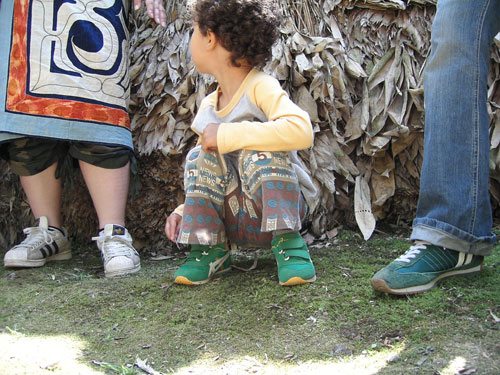
The shaded awnings of the chise is where some people, including my son, elected to stand during the outside portion of the Chi-nomi-Shiri-Kamuy-nomi Ainu prayer festival held May 27.
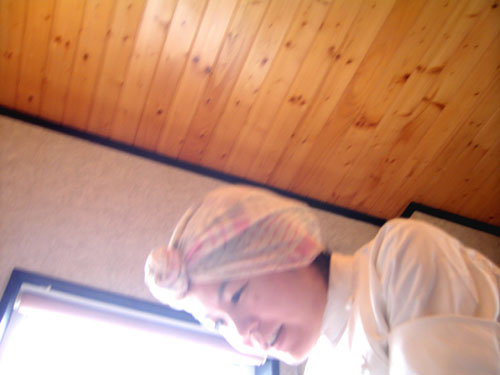
Chie is a sublime cook, and she mixes the spices perfectly every time. I could gush on and on, but simple enough to say our family loves her and her food very much. I think the greatest cooks are often great people, too, as is true of Chie (and Aunt Michele in the D). Chie is a kind-hearted and gentle soul. My son, who is often particular about whom he pays attention to, has no qualms about giving Chie a very low bow of thanks after he has eaten his full.
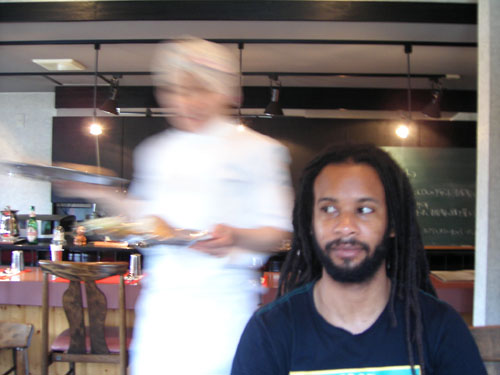
Tucked down a side street near Kaguraoka park is my favorite restaurant in town. (And you may recall that I earlier wrote about my favorite cafe, Chamomile Cafe, here).
The restaurant is called, of all things, Hindi Hipster, and it is run by a single proprieter, Chie, who has homestayed in India maybe 5 times to learn directly from the real folks how to cook Indian food.
Here you see my husband full of anticipation prior to digging into the lunch set for vegetarians: eggplant curry with rice, chapati, samosa, and salad. My mouth waters just thinking about it.
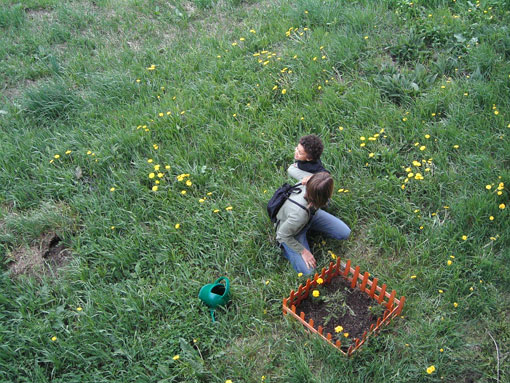
Here it is!
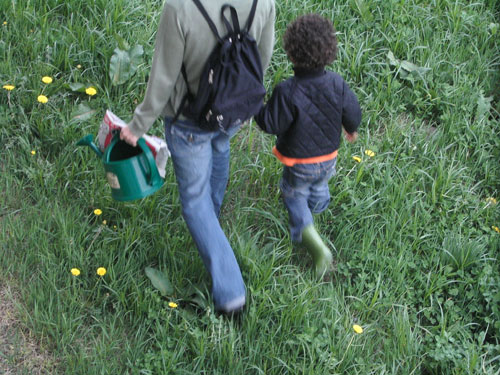
Out back of our dilapidated public housing is an unkempt field of beauty. A sturdy pine tree, in its classic Christmas shape, stands near to where a house used to be long ago. Dragon willow trees spring and curl up tenaciously even though the city workers mow them down, and now patches of daffodils and a few single ruby red tulips grow among the tall grasses along with wild asparagus, small purple flowered ground cover, and dandelions.
This year I decided I would create a miniature garden, although no one else in our building has done so, and I would do it without asking for anyone’s permission. Boldness comes to those who have little time left on their contracts, I suppose. I pulled a heavy sack of soil around back, purchased a mini shovel and scoop, and planted three marigolds and one tomato plant in the middle of all that wild life. My husband helped me get up the toughest weeds until we created a small guerilla garden. The plants are loving their new home, and already a small yellow flower has bloomed on the tomato plant. I put up some wooden fencing so that the city mowers might take heart and not murder them with their electric weed-whackers, as they invade the field and slice up the other vegetation twice a year.
I am not sure they will show deference in their work, as they have previously hacked up my son’s Thomas the Tank Engine he had dropped over the veranda last year. But for now, I will believe in the basic goodness of humans, and I think they will understand the very human desire to bite into a juicy sun-ripened tomato, so much more pleasurable than those mass produced types grown by unknown people in unknown places.
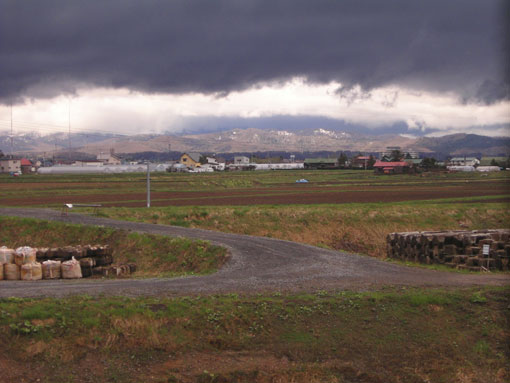
There are days when the weather gives us something unexpected, a gift of unusual light and depth of color.
This morning on our way to my son’s school, we saw storm clouds forming at all four directions of the city, and since we are surrounded by mountains, only half of the world had traces of a radiant mellow sun. The rest was the storm’s foreboding arrival as grey as factory smoke.
It is hard to explain its singular beauty, so I took a few photos of it to share with you all. Nature’s gift to you.
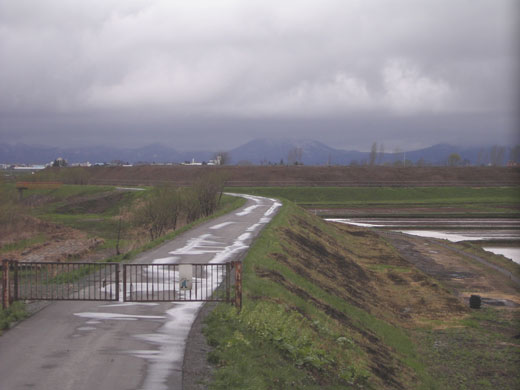
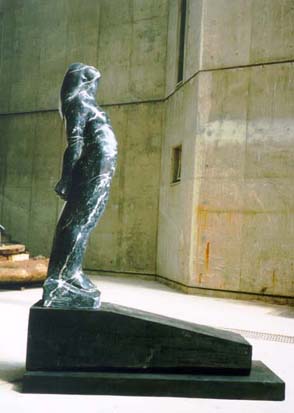
This piece was made by the sculptor, Mikako Tomotari, in dedication to the Ainu lands submerged by the Hokkaido government-sponsored dam in the Nibutani area of Hokkaido. Her comments and then comments on her comments (in English) are here.
She had wanted to throw it into the waters, so that only by the elimination of the dam could it be revealed to our eyes.
I think I read somewhere else that it was set near the damn instead, though.
Her sculpture demands that we re-think how so-called technological developments impact our land and the people who live on it (though, to be honest, no one really knows the benefits of this particular dam, besides the construction company and maybe the pockets of a few politicians, since its reason to exist–a proposed industrial park–never came to be).
In a similar way, I think I am trying to use the classroom as a space for some Ainu people to meet and speak with the primarily wajin university students. By listening to other ways of seeing, we have the chance to deepen and expand our ideas about how to live and why we live.
This week we watched the film, BARAKA, in class, which also celebrates the beauty of our world and at the same time unites us as fellow humans trying to make a life as best we can for our short time here. One student said he understood better how Japanese Zen Buddhism must seem odd for others not from Japan, and he imagined it must be how he felt when watching the scene in Bali of the Javanese men moving and singing in synchronicity.
For me, I realized again that the power of seeing up close the eyes and faces of other humans, and even the faces of animals (in the film there is the close-up of the snow monkeys in Japan, and one old monkey in the hot spring meditates, with his eyes slowly closing, just as any human would). In these unedited close-ups I feel the connection between us, no matter how different we may seem superficially.
Maybe our world leaders need to watch this film for 3-days-straight, without food or water. Would they then re-emerge more aware of the world’s interconnectedness, more in-tune as to how a death–even if they wish to soften it by calling it ‘collateral damage’– happening way over in another country due to their policies impacts the entire planet, impacts everyone’s quality of life? We are all diminished by the deaths of war. Do they care how their decisions design so many deaths and so many miseries? I think they will all realize it someday, preferably long before their eyes glaze over in that last moment of awareness, and I hope they can alter their ways.
I sound a tad grim perhaps, but I am not feeling grim. I just wish for more sanity and love. Today, not tomorrow!
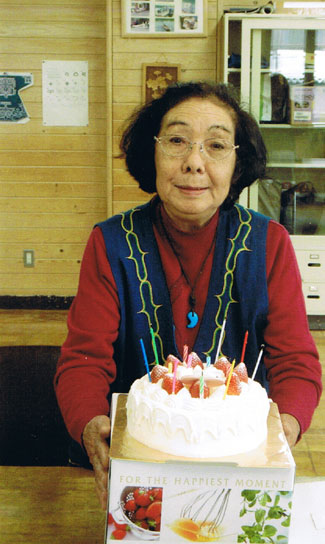
HAPPY BIRTHDAY, FUCHI!
Fuchi is the coolest 71-year-old I know. She teaches the bi-monthly class in Ainu embroidery, and I love her for her quick wit, candor, and bright sunshine-y energy.
Unlike most folks I’ve met in Japan, she gives people hugs and double-handed handshakes without hesitation. She helps us stitch and design our work and often tells us tales of her 50-year old stint at marriage and about being an Ainu woman in Hokkaido. She has a lot of strength and power. No one can keep her down.
Here’s to hoping we can all live our lives to the fullest each & every day–no matter what we may face.
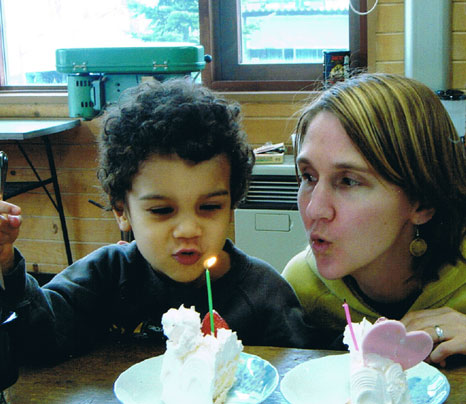
Here my son and I partake in the saved birthday cake (we got there late). As an example of Fuchi’s super-big heart, she made sure we both had a strawberry and wishes to make, and then, for some reason, she put the pink chocolate heart on my slice. Now ain’t she a sweetie? Love live Fuchi!!!
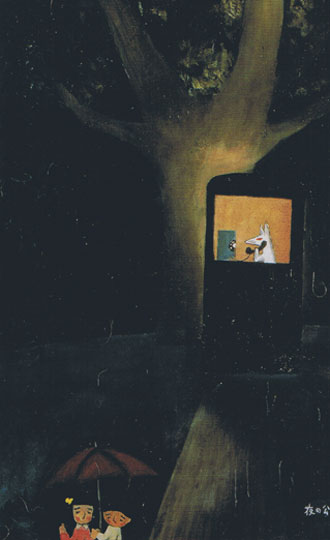
(c) Michiko Taniuchi (scanned postcard)
An example of Taniuchi Roku’s art: Two children out on a rainy night spot a white fox making a phone call. A mix of sweetness, magic, mystery, eeriness and whimsy.
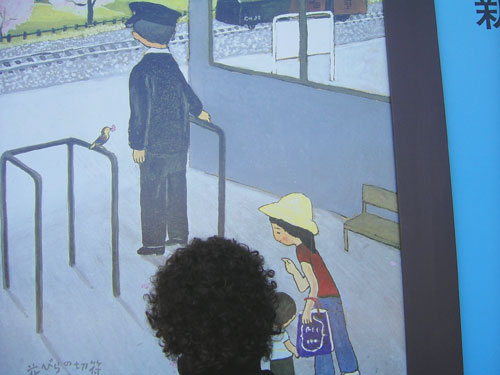
My son and I went to an exhibit last weekend of the illustrator Taniuchi Roku. The event was sandwiched in between two hours of playing outside in the warm sunshine and a thick slice of buttered toast eaten on twistable stools at the museum’s cafe, so perhaps these two conditions helped heighten our appreciation of the art. But his work was sweet, verging on cute, usually from a child’s eye-view, but I thought the mix of occasional humorous or imaginative elements made it magical. Of course, my son appreciated the abundance of trains in the paintings.
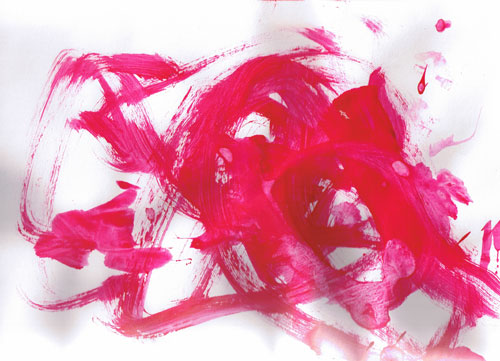
Painting by my beautiful son (age 3 years and 4 months)
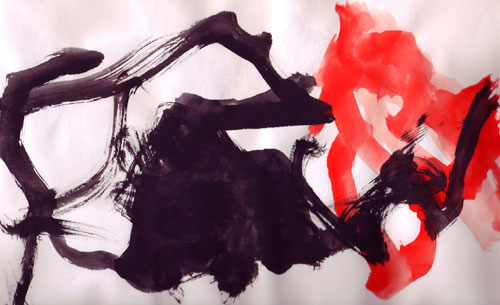
Painting by my beautiful son (age 3 years and 4 months)
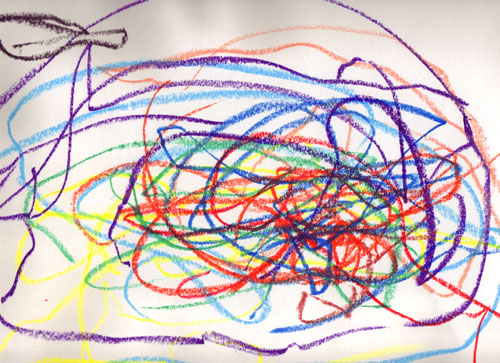
Drawing by my beautiful son (age 3 years and 4 months)
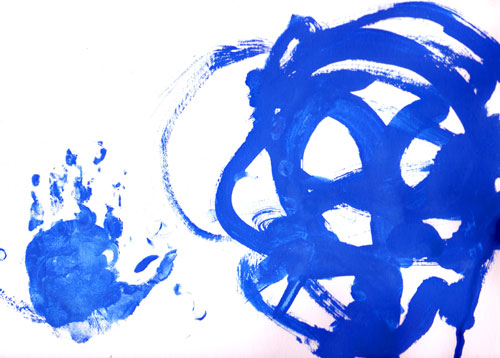
Painting by my beautiful son (age 3 years and 4 months)
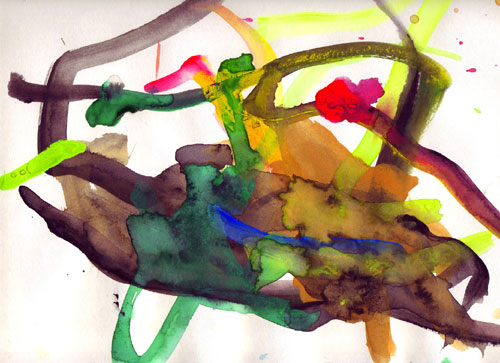
Painting by my beautiful son (age 3 years and 4 months)
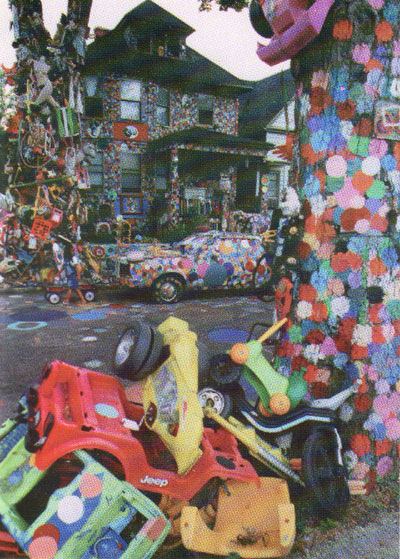
Scanned postcard: photo by Donna Terek
The Dottie Wottie House: Dr. Martin Luther King, Jr. said,
“We are all the same color on the inside.”
On the east-side of Detroit there is a street unlike any other you’ll probably ever see, called Heidelberg, and its array of polka dots, riots of blue, purple, pink, red, and yellow, all shapes and sizes of shoes, high heels to summer flip-flops to tuxedo spats line the walkways and the tree branches. Baby dolls painted black with colorful crosses and broken limbs lie next to old suitcases and vacuum cleaners, and then numerous boards and car hoods painted with bold faces called the ‘Faces of God.’ This neighborhood is a living, continuous artspace called the Heidelberg Project started by the artist Tyree Guyton. It’s famous and infamous, depending on your attitude toward public and spontaneous art, yet personally as a lover of both rebellious spirits and of outsider art, I am a believer in this magical place.
I worked for a few times with the Heidelberg Project’s sponsored local elementary school, Bunche, teaching Japanese calligraphy and painting rocks for their art garden–very sweet and talented group of kids. They had no art education at the school due to funding cuts, which is such a sad thing. I am not sure if that is still the case, but my guess is, yes….
No child left behind ? Yeah, right. Go to any school in a poor neighborhood and try to say that with a straight face.
You can find out a lot more about Guyton’s Heidelberg Project and vision here.
“We are all the faces of God.
He said he made us in his image and likeness…and that says to me that God has a lot of faces.”
–Tyree Guyton
His artwork can be seen on his website here:
The Heidelberg Project is now trying to create a House That Makes Sense, an artist’s residence and children’s art workshop, and covering a house with something like 875,000 pennies. Send them your pennies, people!
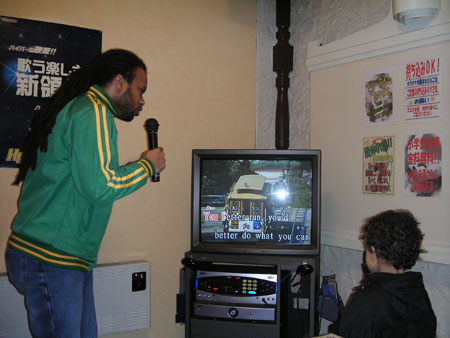
Believe it or not, this is the first time father and son have teamed up together to sing karaoke in a karaoke room.
The chosen hit-song, “Beat It,” by Michael Jackson. Can you feel the magic?